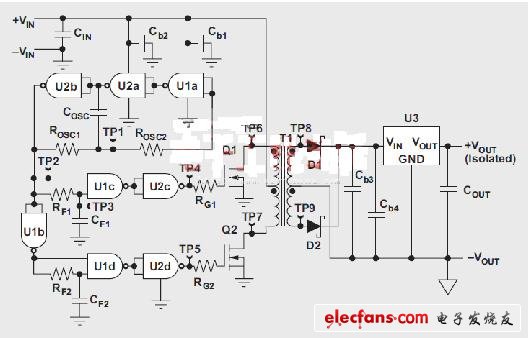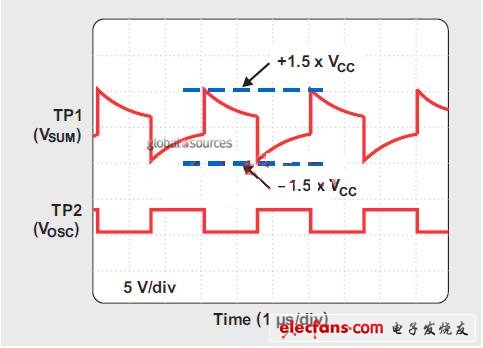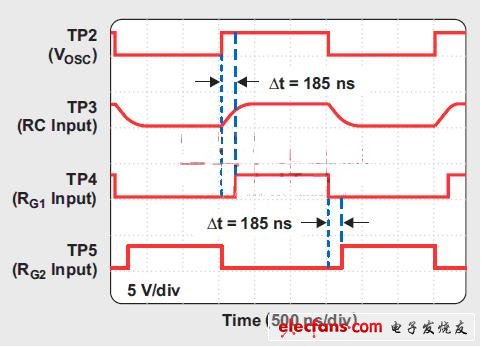Isolated 3.3V to 5V converters are commonly used in long-distance data transmission networks where the bus node controller operates from a 3.3V supply to conserve power while the bus voltage is 5V to ensure long-distance transmission. Signal integrity and high drive capability. Although there are already isolated DC/DC converter components with 3.3V to 5V conversion on the market, the integrated 3.3V to 5V converter is still difficult to find. Even if found, these particular converters (especially those with stable outputs) typically have longer product delivery times, are relatively expensive, and generally have some isolation voltage limitations.
The discrete DC/DC converter design shown in Figure 1 uses only some of the existing standard components (such as logic ICs and MOSFETs) to serve the transformer driver and an LDO for stabilizing the output voltage. This circuit uses many The via assembly is made into a prototype that is larger than the integrated component, but thanks to TI's Little Logic device, board space is greatly reduced.
The main benefits of this design are fewer bill of materials (BOM) and the freedom to choose an isolation transformer for isolation voltages in the 1 to 6kV range. Our goal is to provide a low-cost alternative by making the transformer driver stage a stable output fully integrated DC/DC converter and stand-alone transformer driver.

Figure 1: Isolated 3.3V to 5V push-pull converter
working principle
Low cost, isolated DC/DC converters are typically push-pull drive types. The working principle is very simple. A square wave oscillator with a push-pull output stage drives a center-tapped transformer whose output is rectified for stable or unsteady DC use. An important functional requirement is that the square wave must have a 50% duty cycle to ensure symmetric magnetization of the transformer core. Another requirement is the product of the magnetization voltage (E) and the magnetization time (T) (called the ET product in units of Vμs) and must not exceed the typical ET product of the transformer specified by its manufacturer. We must also install the break-before-make circuit next to the oscillator to prevent the two transformer cores in the push-pull output stage from conducting at the same time, causing circuit failure.
Discrete design
The famous three-phase-backdoor oscillator consists of U1a, U2a, and U2b, which is chosen because it is more stable in terms of power supply fluctuations. With a 100-pF ceramic capacitor (COSC) and two 10-kΩ resistors (ROSC1 and ROSC2), its normal frequency is set to 330kHz. Within the 3.0-V to 3.6-V supply voltage fluctuation range, the oscillator It has a duty cycle of nearly 50% and a maximum frequency fluctuation of less than ±1.5%. Figure 2 shows the waveforms at the addition point of ROSC1 and ROSC2 (TP1) and the oscillator output (TP2). All voltages are measured with reference circuit reference voltage.

Figure 2: Oscillator waveforms for TP1 and TP2
The Schmitt trigger circuit NAND gates (U1c, U1d) implement the break-before-make function to avoid overlapping of the MOSFET turn-on phases. The other two NAND gates (U2c, U2d) are configured as inverting buffers to produce the correct signal polarity necessary to drive the N-channel MOSFETs (Q1, Q2). Figure 3 shows the complete break-before-make action. To accommodate the limited drive capability of standard logic gates, we chose MOSFETs because of their lower total charge and shorter response time.

Figure 3: Waveform before break
Barium titanate lead-free piezoelectric ceramics are important basic materials for the development of modern science and technology, which was widely used in the manufacture of ultrasonic transducers, underwater acoustic transducers, electroacoustic transducers, ceramic filters, ceramic transformers, ceramic frequency discriminators, high voltage generators, infrared detectors, surface acoustic wave devices, electro-optic devices, ignition and detonation devices, and piezoelectric gyroscope and so on.
Application: military, ocean, fishery, scientific research, mine detection, daily life and other fields.

Piezoelectric Ring,Lead Free Piezoelectric Ring,Piezo Electric Ring,Lead Free Piezo Rings
Zibo Yuhai Electronic Ceramic Co., Ltd. , https://www.yhpiezo.com